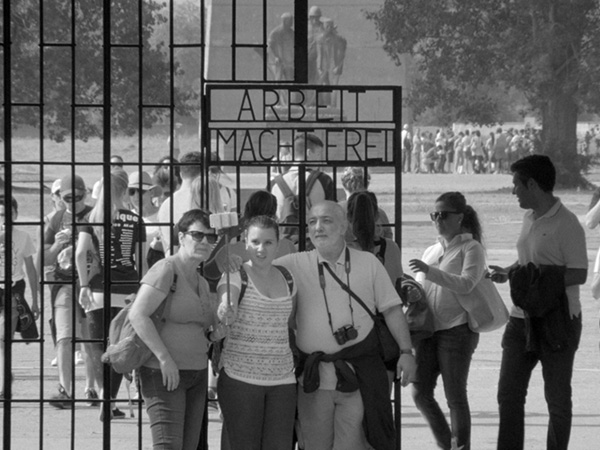Director: Sergei Loznitsa,
Watched on: Filmatique,
Rating: 4.5.
On first glance, the irony of this film’s premise is almost too simple: hordes of selfie-sticked tourists descend on Germany’s concentration camps to check “Holocaust memorials” off their bucket list. But after the requisite huff of judgement directed towards the T-shirted visitors and a grunting suspicion that the filmmaker is settling in for one long smirk, things get interesting pretty quickly.
Quickly might be the wrong adverb. Director Sergei Loznitsa’s film is composed of long, static takes, many running five minutes or more, in which we observe from a respectful distance the shuffling of tourists through barracks and killing grounds, peering into cells and crematoriums, listening to audio tours and snapping pics with their smartphones. We are several minutes into the film before we see the Arbeit macht frei signage over the entry, mostly obscured by the crowds. Then scenes inside of families, couples, groups doing what tourists do: paying half-attention, yawning, fingering phones, snacking, guzzling water while wearing shorts and T-shirts on a hot summer day. Most look quickly through windows or at plaques and then move on. “Who are these disrespectful louts,” we want to say, “treating humanity’s greatest tragedy with all the reverence of an aqua park?”
Then we realize the louts are us.
The film’s title is taken from a 2001 book by W.G. Sebald, in which the main character, Jacques Austerlitz, a member of the kindertransport which saved the lives of 10,000 children before the outbreak of World War II, conducts a lengthy, labyrinthine search for clues to his mother’s fatein a concentration camp. Sebald’s great skill–he was a master at interrogating the painful obsessions of memory and the subjectivity of truth filtered by the passage of time–is reflected in Loznitsa’s inquiring camera.
How much should one be reverent in the presence of empty monuments to horror, when we’ve all watched the films and read the books and personally imagined the unimaginable many times already? Should the camps be allowed to eventually decay and fold back into farmland, or maybe the land razed and turned into foundations for office parks? Or should Holocaust tourists be required to don prison stripes, keep quiet and orderly, and then plod through the sites on a reservations-only time schedule, as if viewing a long-lost Da Vinci?
The most remarkable and even stirring element of Austerlitz is that these questions are never meant to be answered. In fact, while immersed in the long takes and buffeted by the quiet gaggle of sound (there is no music, narration, onscreen text, or interviews), you will likely sift through a number of reactions, questions, and retracted judgements. Is it wrong for the guy to wear a T-shirt that reads Cool story, bro? What about the other T-shirts emblazoned with corporate logos? The film is shot in black-and-white, a merciful directorial choice to counter the distraction of all that color. But the question remains. What should we wear on a hot day while on vacation?
But then we see a woman who has her picture taken in front of the ovens. And then, in a busy background shot, a man poses with his arms stretched above his head against the poles the SS used to torture prisoners. This act seems to be particularly insensitive. Or is it simply a normal response by a visitor to modern culture’s “pics or it didn’t happen” Instagrammed lives? Who are we to criticize?
Austerlitz is about how we consume the memories of others. The movie deals in both physical and metaphorical reflections. Visitors are seen in window panes, and see themselves in Loznitsa’s lens. Some notice the discreetly placed camera, and even seem to be mildly perturbed by it, but they don’t suddenly change their behavior, slow down, or try to appear more engaged. Why should they? Loznitsa seems to be confirming his, and our, complicity in the way we treat memorials to the ugly chapters of humanity, and in the way governments decide to validate these memorials by advocating for their existence. But he also allows a capacity for serious thought.
Just when we think we’ve had enough of the whole Holocaust tourism scene, he observes people reading a plaque off-screen. Behind them is a larger-than-life sculpture of an emaciated prisoner lifting a skeletal corpse. The tourists finally seem to be concentrating, paying attention, tuned to the gravity of the experience.
And in the film’s final scenes, the hordes exit the camp, passing again the scrolled Arbeit macht frei (the irony of the visitors’ release is meant to be obvious), with the last group wearing T-shirts embroidered with the words “Travel For Peace.” Yes, we are human, and so we are exhausted by the wearying demands of required solemnity, but hey, at least we’re trying. We show up.

